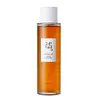What's inside
What's inside
 Key Ingredients
Key Ingredients

 Benefits
Benefits

 Ingredients Side-by-side
Ingredients Side-by-side

Galactomyces Ferment Filtrate
HumectantSaccharomyces/Panax Ginseng Root Ferment Filtrate
Skin ConditioningLactobacillus/Centella Asiatica Extract Ferment Filtrate
Skin ConditioningWater
Skin ConditioningGlycerin
HumectantButylene Glycol
HumectantBifida Ferment Lysate
Skin ConditioningSaccharomyces Lysate
Skin ConditioningLactobacillus Ferment Lysate Filtrate
Skin ConditioningLactobacillus/Rye Flour Ferment
Skin ConditioningLactobacillus/Soybean Extract Ferment Filtrate
Skin ConditioningLactobacillus/Ganoderma Lucidum Extract/Lentinus Edodes Extract Ferment Filtrate
Skin ConditioningSaccharomyces/Xylinum/Black Tea Ferment
Skin ConditioningLactobacillus/Algae Extract Ferment
Skin Protecting3-O-Ethyl Ascorbic Acid
Skin ConditioningGlucomannan
Skin ConditioningSorbitol
HumectantXylitol
HumectantAcetyl Glucosamine
Skin ConditioningCentella Asiatica Leaf Extract
Skin ConditioningGlutathione
Pseudoalteromonas Ferment Extract
HumectantSh-Polypeptide-121
Skin ConditioningPalmitoyl Hexapeptide-12
Skin ConditioningAcetyl Hexapeptide-8
HumectantLeuconostoc/Radish Root Ferment Filtrate
Antimicrobial1,2-Hexanediol
Skin ConditioningPhenoxyethanol
PreservativeHydroxyacetophenone
AntioxidantSodium Citrate
BufferingHydrolyzed Sodium Hyaluronate
Skin ConditioningCitric Acid
BufferingSodium Acetylated Hyaluronate
HumectantCaprylyl Glycol
EmollientBis-PEG-18 Methyl Ether Dimethyl Silane
EmollientGalactomyces Ferment Filtrate, Saccharomyces/Panax Ginseng Root Ferment Filtrate, Lactobacillus/Centella Asiatica Extract Ferment Filtrate, Water, Glycerin, Butylene Glycol, Bifida Ferment Lysate, Saccharomyces Lysate, Lactobacillus Ferment Lysate Filtrate, Lactobacillus/Rye Flour Ferment, Lactobacillus/Soybean Extract Ferment Filtrate, Lactobacillus/Ganoderma Lucidum Extract/Lentinus Edodes Extract Ferment Filtrate, Saccharomyces/Xylinum/Black Tea Ferment, Lactobacillus/Algae Extract Ferment, 3-O-Ethyl Ascorbic Acid, Glucomannan, Sorbitol, Xylitol, Acetyl Glucosamine, Centella Asiatica Leaf Extract, Glutathione, Pseudoalteromonas Ferment Extract, Sh-Polypeptide-121, Palmitoyl Hexapeptide-12, Acetyl Hexapeptide-8, Leuconostoc/Radish Root Ferment Filtrate, 1,2-Hexanediol, Phenoxyethanol, Hydroxyacetophenone, Sodium Citrate, Hydrolyzed Sodium Hyaluronate, Citric Acid, Sodium Acetylated Hyaluronate, Caprylyl Glycol, Bis-PEG-18 Methyl Ether Dimethyl Silane
Panax Ginseng Root Water
MaskingButylene Glycol
HumectantGlycerin
HumectantPropanediol
SolventNiacinamide
Smoothing1,2-Hexanediol
Skin ConditioningWater
Skin ConditioningHydroxyacetophenone
AntioxidantGlyceryl Glucoside
HumectantXanthan Gum
EmulsifyingPanthenol
Skin ConditioningDipotassium Glycyrrhizate
HumectantAllantoin
Skin ConditioningAdenosine
Skin ConditioningPanax Ginseng Callus Culture Extract
Skin ConditioningTheobroma Cacao Extract
Skin ConditioningDextrin
AbsorbentGlucose
HumectantPanax Ginseng Root Extract
EmollientPanax Ginseng Berry Extract
Skin ConditioningLactobacillus
Skin ConditioningSodium Hyaluronate
HumectantEthylhexylglycerin
Skin ConditioningDisodium EDTA
Panax Ginseng Root Water, Butylene Glycol, Glycerin, Propanediol, Niacinamide, 1,2-Hexanediol, Water, Hydroxyacetophenone, Glyceryl Glucoside, Xanthan Gum, Panthenol, Dipotassium Glycyrrhizate, Allantoin, Adenosine, Panax Ginseng Callus Culture Extract, Theobroma Cacao Extract, Dextrin, Glucose, Panax Ginseng Root Extract, Panax Ginseng Berry Extract, Lactobacillus, Sodium Hyaluronate, Ethylhexylglycerin, Disodium EDTA
 Reviews
Reviews

Ingredients Explained
These ingredients are found in both products.
Ingredients higher up in an ingredient list are typically present in a larger amount.
1,2-Hexanediol is a synthetic liquid and another multi-functional powerhouse.
It is a:
- Humectant, drawing moisture into the skin
- Emollient, helping to soften skin
- Solvent, dispersing and stabilizing formulas
- Preservative booster, enhancing the antimicrobial activity of other preservatives
Butylene Glycol (or BG) is used within cosmetic products for a few different reasons:
Overall, Butylene Glycol is a safe and well-rounded ingredient that works well with other ingredients.
Though this ingredient works well with most skin types, some people with sensitive skin may experience a reaction such as allergic rashes, closed comedones, or itchiness.
Learn more about Butylene GlycolGlycerin is already naturally found in your skin. It helps moisturize and protect your skin.
A study from 2016 found glycerin to be more effective as a humectant than AHAs and hyaluronic acid.
As a humectant, it helps the skin stay hydrated by pulling moisture to your skin. The low molecular weight of glycerin allows it to pull moisture into the deeper layers of your skin.
Hydrated skin improves your skin barrier; Your skin barrier helps protect against irritants and bacteria.
Glycerin has also been found to have antimicrobial and antiviral properties. Due to these properties, glycerin is often used in wound and burn treatments.
In cosmetics, glycerin is usually derived from plants such as soybean or palm. However, it can also be sourced from animals, such as tallow or animal fat.
This ingredient is organic, colorless, odorless, and non-toxic.
Glycerin is the name for this ingredient in American English. British English uses Glycerol/Glycerine.
Learn more about GlycerinHydroxyacetophenone is antioxidant with skin conditioning and soothing properties. It also boosts the efficiency of preservatives.
This ingredient is not irritating or sensitizing.
Water. It's the most common cosmetic ingredient of all. You'll usually see it at the top of ingredient lists, meaning that it makes up the largest part of the product.
So why is it so popular? Water most often acts as a solvent - this means that it helps dissolve other ingredients into the formulation.
You'll also recognize water as that liquid we all need to stay alive. If you see this, drink a glass of water. Stay hydrated!
Learn more about Water